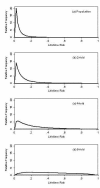Disease-specific prospective family study cohorts enriched for familial risk
- PMID: 21352566
- PMCID: PMC3055804
- DOI: 10.1186/1742-5573-8-2
Disease-specific prospective family study cohorts enriched for familial risk
Abstract
Most common diseases demonstrate familial aggregation; the ratio of the risk for relatives of affected people to the risk for relatives of unaffected people (the familial risk ratio)) > 1. This implies there are underlying genetic and/or environmental risk factors shared by relatives. The risk gradient across this underlying 'familial risk profile', which can be predicted from family history and measured familial risk factors, is typically strong. Under a multiplicative model, the ratio of the risk for people in the upper 25% of familial risk to the risk for those in the lower 25% (the inter-quartile risk gradient) is an order of magnitude greater than the familial risk ratio. If familial risk ratio = 2 for first-degree relatives, in terms of familial risk profile: (a) people in the upper quartile will be at more than 20 times the risk of those in the lower quartile; and (b) about 90% of disease will occur in people above the median. Historically, therefore, epidemiology has compared cases with controls dissimilar for underlying familial risk profile. Were gene-environment and gene-gene interactions to exist, environmental and genetic effects could be stronger for people with increased familial risk profile. Studies in which controls are better matched to cases for familial risk profile might be more informative, especially if both cases and controls are over-sampled for increased familial risk. Prospective family study cohort (ProF-SC) designs involving people across a range of familial risk profile provide such a resource for epidemiological, genetic, behavioural, psycho-social and health utilisation research. The prospective aspect gives credibility to risk estimates. The familial aspect allows family-based designs, matching for unmeasured factors, adjusting for underlying familial risk profile, and enhanced cohort maintenance.
Figures


References
-
- Peto J. In: Banbury Report 4: Cancer incidence in defined populations. J Cairns, JL Lyon, M Skolnick, editor. Cold Spring Harbor Laboratory; 1980. Genetic predisposition to cancer; pp. 203–213.
-
- Hopper JL, Carlin JB. Familial aggregation of a disease consequent upon correlation between relatives in a risk factor measured on a continuous scale. Am J Epidemiol. 1992;136:1138–47. - PubMed
-
- Khoury MJ, Beaty TH, Liang K-Y. Can familial aggregation of disease be explained by familial aggregation of environmental risk factors? Am J Epidemiol. 1988;127:674–83. - PubMed
-
- Fisher RA. The correlation between relatives on the supposition of Mendelian inheritance. Trans Roy Soc Edinb. 1918;52:399–433.
LinkOut - more resources
Full Text Sources

